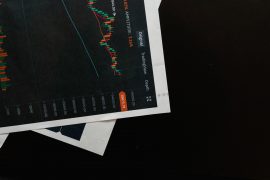
The stock market maintains regular hours, but that doesn’t mean that knowledgeable investors can’t conduct trades before it opens! This is done through the process known as premarket trading. What is premarket trading? How does premarket trading work? When does it make sense to trade stocks outside of the standard stock market hours?
To answer these questions, we’ll be taking a closer look at premarket trading to help you determine whether this might be a valuable investment strategy to pursue.

What Is Premarket Trading?
Premarket trading differs from traditional trading in several key aspects, including:
Hours of Premarket Trading
The two major U.S. stock exchanges are the New York Stock Exchange (NYSE) and the Nasdaq. Both are based out of New York, and both operate on weekdays between the hours of 9:30 AM to 4:00 PM EST.
Premarket trading refers to trading that occurs prior to the usual opening time of 9:30 AM. However, this doesn’t mean that premarket trading isn’t constrained to certain hours, as well. Stock market pre-open hours are set for 4:00 AM to 9:30 AM, Monday through Friday.
Premarket Trade Volumes
At such early hours, few investors are participating in the trading process. This means that the pre-open stock market tends to be defined by relatively less trade volume as compared to trades conducted during regular hours.
Low Liquidity
Premarket sessions are also characterized by thin liquidity. This means that investors have less opportunity to convert stocks into cash. How does this impact investors? Stock prices won’t rise and fall as quickly as they do during regular trading hours.
High Bid-Ask Spreads
During premarket trading, investors might experience high bid-ask spreads. This means there can be quite a bit of difference between the price an investor is willing to spend on a particular asset and the price the seller is willing to accept.

How Does Premarket Trading Work?
Premarket trading differs considerably from traditional stock trades, not only in the hours in which trades are conducted, but also in the actual methods that are used.
How Premarket Trades Are Made
How does premarket trading work? During stock market pre-open hours, investors don’t buy stocks the traditional way. Instead, investors buy and sell securities using electronic exchanges known as electronic communication networks (ECNs).
An ECN doesn’t have a physical location. Instead, the term refers to the digital network that connects investors together.
An ECN is designed to automatically match buy and sell orders at specified prices, which means that the trades that occur during these hours happen without the need of an intermediary. Instead, stock brokers and individuals can conduct trades through the electronic network.
Some retail brokers will help you with premarket trades, though they may also limit the types of orders that can be placed during the pre-open stock market.
Types of Premarket Trades
Most stock orders placed in the pre-open stock market are limit orders. A limit order is an order that is executed only if the stock reaches a specific price.
Imagine, for example, that you want to purchase 10 shares of stock from Company X. Perhaps you’re only willing to invest a maximum of $10,000. Placing a limit order means that your request will only be executed when Company X’s share price drops to $1,000 per share ($1,000 X 10 shares = $10,000).
This isn’t the only order type used in premarket trading, but it’s one of the most commonly used strategies to mitigate investor risk.
The Benefits of Premarket Trading
What is premarket trading used for? There are several advantages of premarket trading that might make it worth it to interested investors.
Premarket trading will allow you to do the following:
React Early to Breaking News
Sometimes, overnight news will influence an investment decision. When a news story breaks outside of regular trading hours, investors can use premarket trading to get a jump on their investments before the next trading day officially begins.
For instance, if a story breaks overnight about a recent corporate development such as a merger or acquisition, investors can react before the market opens the following day.
But it’s also important to be cautious – stock market pre-open activity can often be reversed by events that happen during the regular trading session.
Another catch is that investors have to be in tune with what’s going on with the company’s management, as well as the state of the U.S. economy.
Staying alert to these trends can help with premarket investing, though it’s not always easy to predict stock market behavior after the opening bell, either!
Find Favorable Prices
In some cases, you may be able to find favorable prices during the premarket session, which can help you get a jump on the competition. With this approach, you may beat out others who might be forced to buy shares at a higher price during the normal trading period.
Enjoy Added Convenience
Unless you’re a professional investor, you likely don’t have a lot of time to conduct trades during a busy workday. Premarket trading gives you an additional option for stock trading. It allows you to dabble in the stock market without taking a bite out of your work schedule.
The Risks of Premarket Trading
While the rewards of premarket trading are certainly attractive, the disadvantages of premarket trading shouldn’t be discounted, either. This practice carries such risks as:
Less Premarket Activity
As we noted earlier, there is less activity in the premarket period – and therefore less trade volume. This contributes to the relatively low liquidity and high bid-ask spreads compared to the market during normal trading hours.
In other words, if you want to try your hand at premarket trading, you may simply discover that you have fewer options than you would after 9:30 AM.
Uncertain Prices
There can be a considerable gap between the prices seen in the premarket hours and those seen during the regular trading day. This uncertainty means that buying stock during these hours can be riskier, since you won’t have a clear idea whether you’re investing in a favorable company or if you’re getting the best price imaginable.
A limit order can protect you somewhat, but it won’t necessarily shield you from price fluctuations once the order has been executed.
Limit Orders Might Never Be Executed
While limit orders aren’t the only type of order you can place, they’re easily the most common. But the very conditions that protect you from overspending on an asset can also prevent the order from ever being executed.
For example, a stock might dip in price, but if it doesn’t drop below your specified threshold, you’ll miss out. Again, this is designed to protect you, but it also means you won’t be able to purchase the stock if it moves far away from the limit price.
What About After-Hours Trading?
After-hours trading was actually introduced prior to premarket trading, but the two practices work on parallel principles.
After-hours trading allows investors to trade securities after the close of the stock exchange (4:00 PM EST for our two major U.S. exchanges). Traders can continue to make trades as late as 8:00 PM EST.
Admittedly, this adds yet another layer of flexibility to your investment strategy, though it comes with the same risks and benefits as premarket trading.
Still, the advantages are certainly attractive to investors who keep up with the headlines. For example, CNBC reports that companies like Chipotle and Lyft have experienced a recent boost in after-hours trading, which might lead investors of individual stocks to take advantage of these fluctuations.

Be Prepared Before and After the Bell
Premarket trading demands careful planning and due diligence. We can help with that – and a whole lot more! At Gorilla Trades, our members get access to additional educational resources, stock tips, and the latest tools to monitor their investments. See for yourself by signing up for a free trial, and discover the resources you need to wisely grow your wealth.
